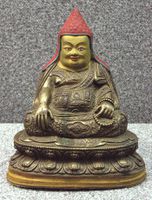Dol po pa: Difference between revisions
m (Saved using "Save and continue" button in form) |
No edit summary |
||
| Line 26: | Line 26: | ||
|images=File:Dolpopa.jpg{{!}}[https://www.himalayanart.org/items/55692 Himalayan Art Resources] | |images=File:Dolpopa.jpg{{!}}[https://www.himalayanart.org/items/55692 Himalayan Art Resources] | ||
|PosBuNayDefProv=Definitive | |PosBuNayDefProv=Definitive | ||
|PosBuNayDefProvNotes="For Dölpopa, the teaching on buddha nature is of definitive meaning and serves as one of the cornerstones of his Shentong view. He typically describes both buddha nature and the dharmakāya as being ultimately really established, everlasting, eternal, permanent, immutable (ther zug), and being beyond dependent origination." [[Brunnhölzl, K.]], [[When the Clouds Part]], p. 68. | |||
|PosDefProv=Definitive | |PosDefProv=Definitive | ||
|PosAllBuddha=Yes | |PosAllBuddha=Yes | ||
|PosAllBuddhaMoreNotes="The crucial stanza [RGV] I.27, in which the three reasons for the presence of a buddha nature in sentient | |||
beings are presented, is thus explained in the following way: | |||
Since the dharmakāya of the perfect buddha embraces and pervades all phenomena, since there is no differentiation [to be made] within the dharmatā concerning all samsāra and nirvāna, and since the potential of the tathāgata exists in all sentient beings as the natural purity of the dharmadhātu, which can be purified of hindrances, truly every being possesses, always, continuously, | |||
and throughout beginningless time, the ultimate | |||
essence of the Buddha." [[Mathes, K.]], [[A Direct Path to the Buddha Within]], p. 82. | |||
|PosWheelTurn=Third Turning | |PosWheelTurn=Third Turning | ||
|PosZhenRang=Zhentong | |PosZhenRang=Zhentong | ||
Revision as of 12:05, 7 March 2018
| PersonType | Category:Author |
|---|---|
| MainNamePhon | Dolpopa Sherab Gyaltsen |
| MainNameTib | དོལ་པོ་པ་ཤེས་རབ་རྒྱལ་མཚན་ |
| MainNameWylie | dol po pa shes rab rgyal mtshan |
| AltNamesTib | ཤེས་རབ་རྒྱལ་མཚན་ · ཤེས་རབ་མགོན་ · རྟོན་པ་བཞི་ལྡན་ |
| AltNamesWylie | shes rab rgyal mtshan · shes rab mgon · rton pa bzhi ldan |
| YearBirth | 1292 |
| YearDeath | 1361 |
| BornIn | gtsang stod mnga' ris dol po gru gsum spu mdo |
| TibDateGender | Male |
| TibDateElement | Water |
| TibDateAnimal | Dragon |
| TibDateRabjung | 5 |
| ReligiousAffiliation | Jonang |
| StudentOf | tshul khrims snying po · skyi ston 'jam dbyangs · skyi ston grags pa rgyal mtshan · sa skya slob dpon shes rab bzang po · gzhon nu bzang po · blo gros bstan pa · jo gdan mkhan po bsod nams grags pa · nag 'bum · jo nang chos rje yon gtan rgya mtsho |
| TeacherOf | jo nang lo tsA ba blo gros dpal · g.yag sde paN chen · bsod nams rgyal mtshan · phyogs las rnam rgyal · sa bzang ma ti paN chen blo gros rgyal mtshan · Drikung Lotsāwa Maṇikaśrī · nya dbon kun dga' dpal · kun spangs chos grags dpal bzang |
| BDRC | https://www.tbrc.org/#!rid=P139 |
| Treasury of Lives | https://treasuryoflives.org/biographies/view/Dolpopa-Sherab-Gyeltsen/2670 |
| Himalayan Art Resources | https://www.himalayanart.org/search/set.cfm?setID=1595 |
| IsInGyatsa | No |
| PosBuNayDefProv | Definitive |
| PosBuNayDefProvNotes | "For Dölpopa, the teaching on buddha nature is of definitive meaning and serves as one of the cornerstones of his Shentong view. He typically describes both buddha nature and the dharmakāya as being ultimately really established, everlasting, eternal, permanent, immutable (ther zug), and being beyond dependent origination." Karl Brunnhölzl, When the Clouds Part, p. 68. |
| PosAllBuddha | Yes |
| PosAllBuddhaMoreNotes | "The crucial stanza [RGV] I.27, in which the three reasons for the presence of a buddha nature in sentient
beings are presented, is thus explained in the following way:
Since the dharmakāya of the perfect buddha embraces and pervades all phenomena, since there is no differentiation [to be made] within the dharmatā concerning all samsāra and nirvāna, and since the potential of the tathāgata exists in all sentient beings as the natural purity of the dharmadhātu, which can be purified of hindrances, truly every being possesses, always, continuously,
and throughout beginningless time, the ultimate
essence of the Buddha." Klaus-Dieter Mathes, A Direct Path to the Buddha Within, p. 82. |
| PosWheelTurn | Third Turning |
| PosZhenRang | Zhentong |
| PosZhenRangNotes | He was the originator of the terms:
"According to traditional Tibetan accounts, the revolutionary theory that the ultimate is not "empty of an own-being” (rang stong) but “empty of other” (gzhan stong) arose in Dölpopas mind during a Kālacakra retreat at
Jonang. Lhai Gyaltsen informs us that Dölpopas realization was connected with the Kãlacakratantra and the construction of the great stüpa in Jonang, which was consecrated in 1333. One of the first works in which
Dölpopa expressed his new zhentong understanding of the Buddhist doctrine was his famous Ri chos nges don rgya mtsho.m His last major work wasthe Bka bsdu bzhipa (Bka' bsdu bzhi pa'i don bstan rtsis chen po, The Great
Reckoning o f the Doctrine That Has the Significance of a Fourth Council), which can be seen as a final summary of Dölpopas views." Klaus-Dieter Mathes, A Direct Path to the Buddha Within, p. 75. |
| PosEmptyLuminNotes | "He typically describes both buddha nature and the dharmakāya as being ultimately really established, everlasting, eternal, permanent, immutable (ther zug), and being beyond dependent origination. He also equates the tathāgata heart with “ālaya-wisdom” as opposed to the ālaya-consciousness." Karl Brunnhölzl, When the Clouds Part, p. 68. |
| Other wikis |
If the page does not yet exist on the remote wiki, you can paste the tag |

